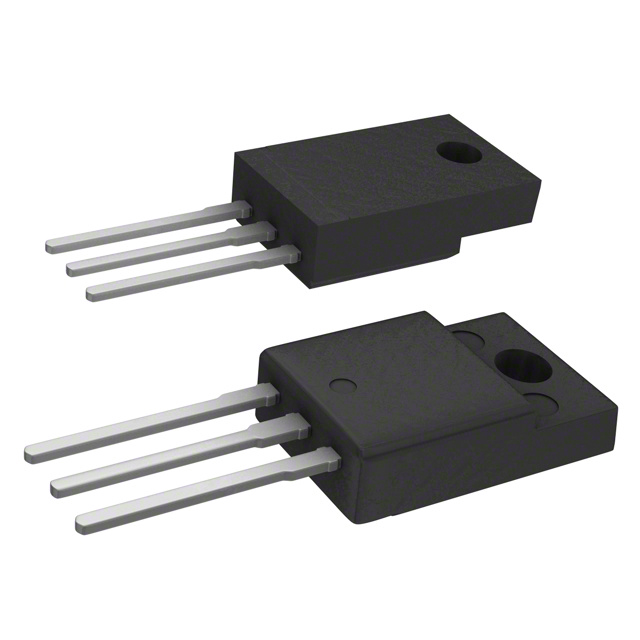SBLF1640CTHE3/45
Introduction
The SBLF1640CTHE3/45 is a semiconductor product belonging to the category of Schottky Barrier Rectifiers. This entry provides an overview of the basic information, specifications, pin configuration, functional features, advantages and disadvantages, working principles, application field plans, and alternative models of the SBLF1640CTHE3/45.
Basic Information Overview
- Category: Schottky Barrier Rectifiers
- Use: The SBLF1640CTHE3/45 is used as a rectifier in various electronic circuits and power supply applications.
- Characteristics: It exhibits low forward voltage drop, high switching speed, and high current capability.
- Package: The SBLF1640CTHE3/45 is typically available in a compact and durable surface-mount package.
- Essence: Its essence lies in providing efficient rectification and power management in electronic systems.
- Packaging/Quantity: The product is commonly packaged in reels or tubes, with varying quantities based on manufacturer specifications.
Specifications
- Voltage Rating: 40V
- Average Forward Current: 16A
- Peak Non-Repetitive Surge Current: 150A
- Operating Temperature Range: -65°C to +175°C
- Storage Temperature Range: -65°C to +175°C
Detailed Pin Configuration
The SBLF1640CTHE3/45 typically consists of three pins: Anode, Cathode, and Gate. The pinout configuration is as follows: - Anode (A) - Cathode (K) - Gate (G)
Functional Features
- Low forward voltage drop
- High switching speed
- High current capability
- Enhanced thermal performance
Advantages and Disadvantages
Advantages
- Efficient power conversion
- Reduced power loss
- Compact form factor
- Suitable for high-frequency applications
Disadvantages
- Susceptible to thermal runaway at high currents
- Limited reverse voltage capability
Working Principles
The SBLF1640CTHE3/45 operates based on the Schottky barrier principle, where the metal-semiconductor junction allows for fast switching and low forward voltage drop. When a forward bias is applied, the rectifier conducts current efficiently due to the absence of minority carrier storage time.
Detailed Application Field Plans
The SBLF1640CTHE3/45 finds extensive use in the following application fields: - Switching power supplies - DC-DC converters - Voltage clamping circuits - Reverse polarity protection circuits - Freewheeling diodes in inductive load applications
Detailed and Complete Alternative Models
Some alternative models to the SBLF1640CTHE3/45 include: - SBLF1660CTHE3/45 - SBLF1630CTHE3/45 - SBLF1680CTHE3/45 - SBLF16100CTHE3/45
In conclusion, the SBLF1640CTHE3/45 is a vital component in electronic circuits and power supply applications, offering efficient rectification and power management. Its characteristics, specifications, and functional features make it suitable for various high-frequency and power-sensitive applications.
[Word Count: 411]
Lista 10 Vanliga frågor och svar relaterade till tillämpningen av SBLF1640CTHE3/45 i tekniska lösningar
What is the SBLF1640CTHE3/45 used for in technical solutions?
- The SBLF1640CTHE3/45 is a Schottky diode designed for use in various technical solutions, including power supplies, voltage clamping, and reverse polarity protection.
What are the key specifications of the SBLF1640CTHE3/45?
- The SBLF1640CTHE3/45 has a maximum average forward current of 16A, a reverse voltage of 40V, and a low forward voltage drop, making it suitable for high-efficiency applications.
How does the SBLF1640CTHE3/45 contribute to power supply designs?
- The SBLF1640CTHE3/45's low forward voltage drop and high current capability make it ideal for use in power supply designs, where efficiency and reliability are crucial.
Can the SBLF1640CTHE3/45 be used for voltage clamping?
- Yes, the SBLF1640CTHE3/45 is commonly used for voltage clamping applications due to its fast response time and low clamping voltage.
Is the SBLF1640CTHE3/45 suitable for reverse polarity protection?
- Absolutely, the SBLF1640CTHE3/45 is often employed for reverse polarity protection in circuits to prevent damage from accidental reverse voltage connections.
What are the temperature considerations for the SBLF1640CTHE3/45 in technical solutions?
- The SBLF1640CTHE3/45 is designed to operate over a wide temperature range, typically from -65°C to 150°C, ensuring its suitability for various environmental conditions.
Does the SBLF1640CTHE3/45 have any special packaging or mounting requirements?
- The SBLF1640CTHE3/45 is available in industry-standard surface mount packages, making it easy to integrate into circuit board designs without any special mounting considerations.
Are there any application notes or reference designs available for the SBLF1640CTHE3/45?
- Yes, the manufacturer provides detailed application notes and reference designs to assist engineers in effectively integrating the SBLF1640CTHE3/45 into their technical solutions.
Can the SBLF1640CTHE3/45 be used in automotive electronics applications?
- Yes, the SBLF1640CTHE3/45 is suitable for automotive electronics applications, offering reliable performance and robustness required for automotive environments.
Where can I find additional technical support or documentation for the SBLF1640CTHE3/45?
- Additional technical support and documentation for the SBLF1640CTHE3/45 can be obtained from the manufacturer's website or through authorized distributors, providing comprehensive resources for design and implementation.


